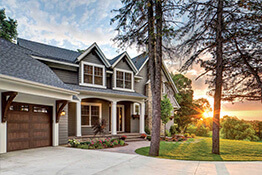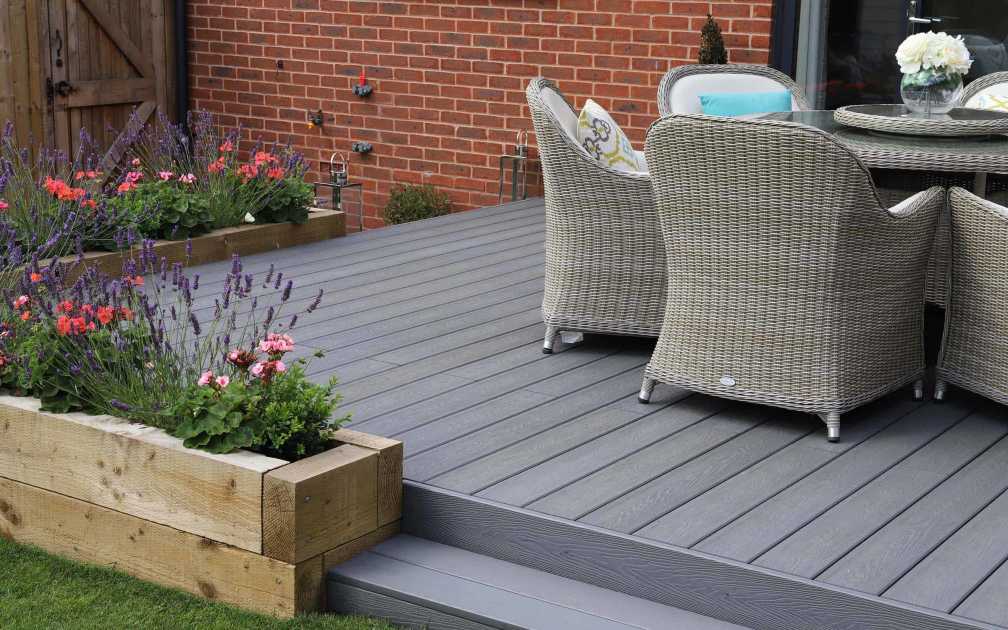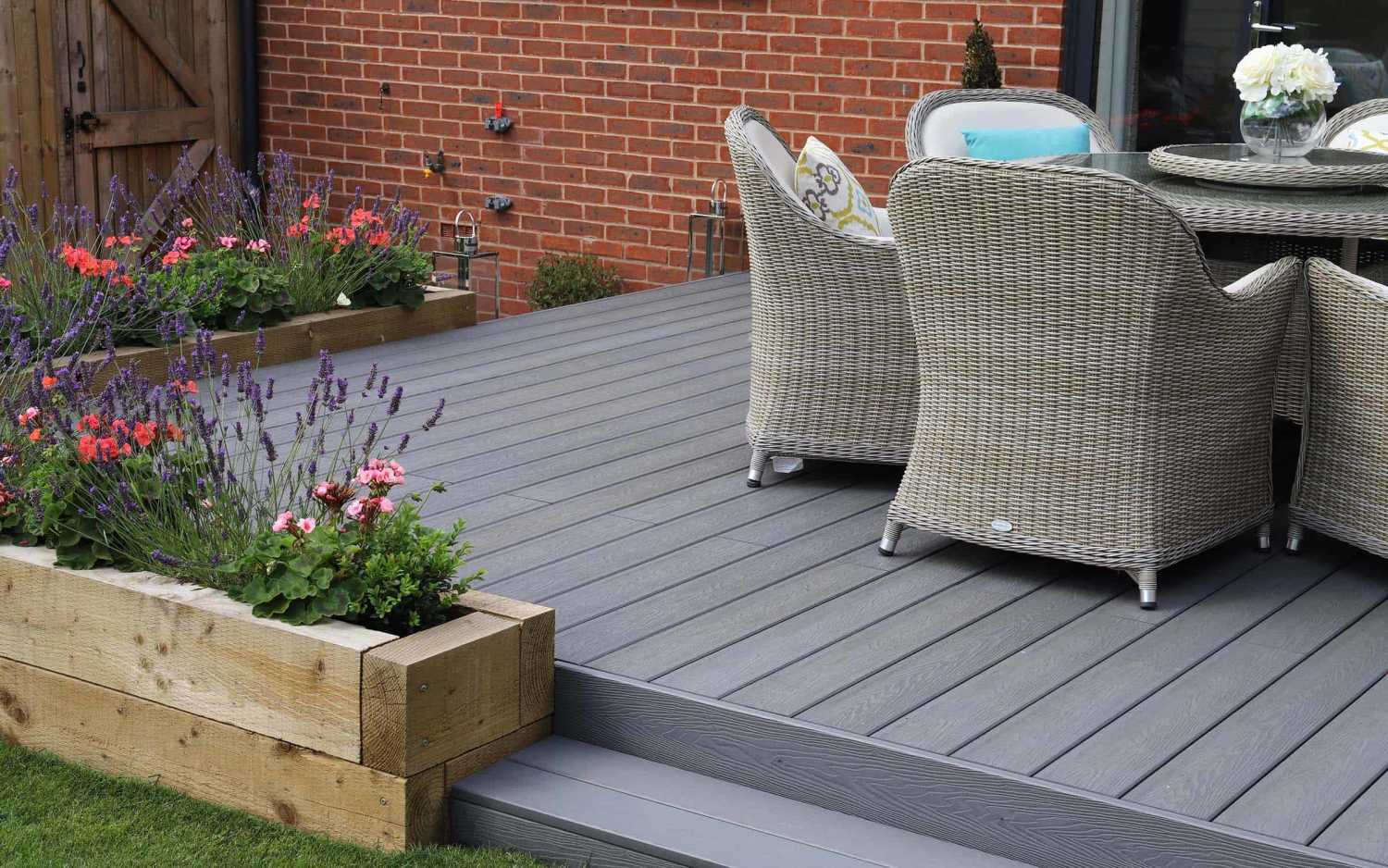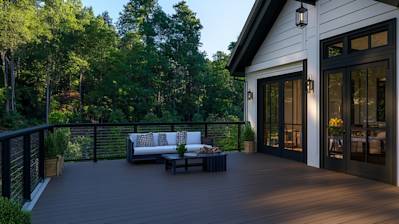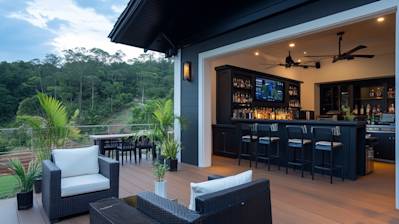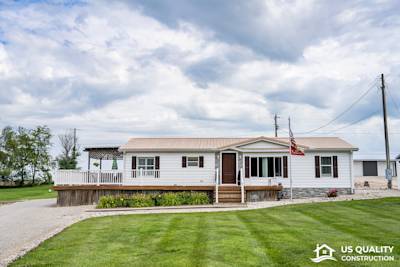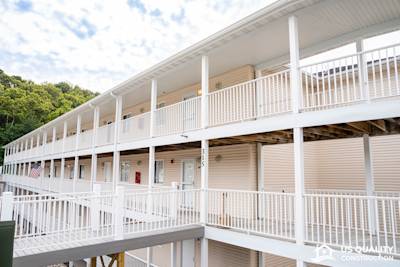Composite decking has dramatically increased in popularity, transforming the way we approach outdoor living spaces. But what exactly is composite decking? Is it beneficial and worth the investment? These are just a few questions often asked by potential buyers. In this article, we'll provide information about composite decking, from its core elements to related aspects like maintenance, installation, and cost.
Understanding Composite Decking
Composite decking is a man-made product typically composed of roughly equal parts of wood fibres and plastic. This combination of natural wood fibre and synthetic materials results in an incredibly durable and long-lasting material perfect for decking.
Materials in Composite Decking
The two primary materials used to create composite decking are both post-industrial recycled wood fibre, and a mix of recycled and new plastics. Some brands use recycled plastic bags, while others use plastic and cellulose fibers. The composite blend is heated, formed into board-shaped lengths and then cooled. The result is a dense, heavy, weather and stain-resistant board that won't splinter, warp, rot, or split - unlike traditional wood decking.
The Evolution of Composite Decking
The development and evolution of composite decking have forged a luxury product that outperforms traditional wooden decking, all while keeping the visual appeal of natural wood. Let’s explore the key stages of development that composite decking has undergone:
First Generation: Capped and Uncapped Composite Decking Boards
- The first generation of composite decking - uncapped composite decking, was made by mixing wood fibres with a resin binder, creating a sturdy but porous material.
- Developers soon realized that the cap’s added layers helped protect the board, giving birth to the second generation called capped composite decking.
Installation of Composite Decking
While composite decking is designed for maximum ease of installation, with boards easily lock into place, the specifics of installation can vary slightly based on the brand or product style you choose. Nevertheless, most brands do share common installation techniques, making installation a manageable task for moderate DIY enthusiasts when equipped with the right tools and safety measures.
Safety during installation
When installing composite decking, always follow safety guidelines provided by the manufacturers. It’s especially crucial to wear the appropriate protective equipment, including safety glasses and gloves.
Maintenance of Composite Decking
Composite decking requires less maintenance than traditional wood decking. It doesn't need staining, sealing, or painting - only occasional cleaning. Composite decking is resistant to fading, staining, scratching, and mold - resulting in a material that retains its beauty and functionality longer than wood.
Cost of Composite Decking
The initial cost of composite decking can be higher than that of wood, but composite materials can be a cost-effective choice in the long run. This is due to its durability and low maintenance requirements, reducing upkeep costs over time.
Warranty and lifespan considerations
Many composite decking manufacturers offer a 25-year warranty on structural integrity, stain & fade, and termite damage. Furthermore, the average lifespan of composite decking is much longer than that of a wooden deck, easily surpassing 25 years with proper care and maintenance.
With these aspects in mind, those considering a new deck can understand why composite decking is gaining popularity among homeowners and contractors alike. Whether seeking an environmentally conscious option or just a deck that saves maintenance time and costs, composite decking offers options that are well-worth consideration.
Frequently Asked Questions About Composite Decking
Why should I consider composite decking for my outdoor space?
Composite decking is an excellent choice for your outdoor space because it offers the beauty of wood without the downsides. It doesn't rot or splinter, it's resistant to pests and weather conditions, and it's low-maintenance, requiring only occasional washing to keep it looking great. Furthermore, it's eco-friendly, often made from recycled materials.
How durable is composite decking?
Composite decking is highly durable. It won't rot, warp, or split like wood, and it's resistant to insects, mold, and mildew. It also withstands weather elements much better than natural wood, and doesn't fade or stain as easily. Composite decks can last 25 to 30 years or even longer with proper care and maintenance.
How does composite decking handle weather and UV exposure?
Unlike wood, composite decking is designed to withstand weather conditions all year round. It doesn't freeze in the winter or become too hot to walk on in the summer. Moreover, it's highly resistant to UV rays, which means it won't fade or discolour significantly when exposed to sunlight.
How does composite decking feel underfoot?
One of the benefits of composite decking is its comfortable feel underfoot. It doesn't splinter like wood, providing a smoother, safer space to walk. Also, it doesn't heat up as much as other materials do in the sun, making it comfortable to walk on even on warmer days.
What types of composite decking are available?
There are two main types of composite decking: capped and uncapped. Capped composite decking has a protective outer layer that provides additional resistance to damage and staining. Uncapped composite decking, while still durable and attractive, lacks this outer layer.
What maintenance does composite decking require?
Composite decking requires far less maintenance than traditional wood decking. You won't need to sand, stain, or refinish your deck every couple of years. Instead, simply clean it occasionally with soap and water to keep it looking fresh and beautiful. Also, keep your deck clear of leaves and debris to prevent mold and mildew.
Can I install composite decking myself?
Yes, with some carpentry skills and the right tools, you can install composite decking yourself. However, keep in mind that it's a big project that requires a great deal of measuring and cutting. Many people choose to hire professionals to ensure it's done properly and quickly.
Does composite decking get slippery when wet?
Quality composite decking materials are designed with a high-traction surface that's not slippery when wet. However, like any other material, algae or mold growth can make the surface slippery if it's not cleaned regularly.
Can composite decking be painted or stained?
One of the advantages of composite decking is that it's designed to maintain its color over time and it doesn't require painting or staining. If you want to change the color of your deck, it's possible to paint or stain it, but it can be a complicated process that may affect the warranty. Before you decide to paint or stain your composite deck, consult with the manufacturer or a professional.
Are there any environmental considerations with composite decking?
Composite decking is a green choice in many ways. Most brands are made from a blend of recycled wood and plastic, reducing landfill waste. Unlike wood, it doesn't require harmful chemicals for maintenance, and its long lifespan means it won't need to be replaced as frequently as traditional wood decks, reducing its environmental impact.
Pros and Cons of Composite Decking
Pros of Composite Decking
1. Durability
- Long-Lasting: Premiere composite decking materials are highly durable, displaying decades of endurance when properly maintained. Often, manufacturers back their offerings with warranties to guarantee longevity.
- Resistance: Composite decking is resistant to factors that usually degrade traditional wood decking. These factors include insect attacks, mold, and rotting, attributing to the material's longer lifespan.
- Maintenance-free: Unlike traditional wood decking, composite decking does not crack or splinter, minimizing the risk of injury while saving costs on routine maintenance and repair work.
2. Aesthetics
- Variety: Composite decking materials come in a wide variety of colors, textures, and finishes resembling natural wood. It allows homeowners to choose a decking material best suited to their visual preferences and home decor.
- Consistency: The manufacturing process of composite decking ensures consistent and long-lasting colors. Unlike wood decking, fading is rarely an issue with the composite variation.
3. Eco-Friendliness
- Recycled materials: Most composite decking materials are made using recycled plastic and wood waste. Choosing composite decking contributes to environmental conservation by reducing landfill waste.
- No harmful chemicals: Unlike pressure-treated wood that contains harmful chemicals, composite decking is safe for both the environment and the people using it.
Cons of Composite Decking
1. Cost
- High initial cost: The purchase and installation of composite decking can be expensive in comparison to other decking materials. Therefore, it may not be the best choice for budget-conscious individuals.
- Long-term financial benefits: Despite the high initial cost, it's worth noting that due to its longevity and low maintenance requirements, composite decking could end up being a more cost-effective choice in the long run.
2. Heat Retention
- Sensitivity to temperature: During hot weather, composite decking may retain more heat compared to traditional wood decking, making it uncomfortable to walk on.
3. Limitations in Design
- Structural limitations: Unlike wood, composite decking cannot be used for structural parts of decks due to its lower strength-to-weight ratio.
- Unalterable: Unlike wood decking that can be sanded or stained to change the appearance, the color and finish of composite decking are unalterable, which may be limiting for some homeowners.
4. Potential Damage
- Scratch sensitivity: While composite decking is resistant to most damages, it can be more prone to scratches from moving furniture or pets, which may not be easily repaired.
- Mold and mildew: Despite being more resistant to mold and mildew than wood, certain types of composite decking can still develop these problems if proper maintenance is not ensured.
Summary
Composite decking has truly transformed outdoor living, offering a practical solution that's visually appealing and built to last. Its resistance to various weather conditions is fantastic and its low-maintenance nature makes it a preferred choice for homeowners. With a wide array of colors and designs available, it effortlessly adds a touch of elegance and sophistication to any space.
The initial investment in composite decking may be higher than traditional wood, but its long lifespan and minimal upkeep costs definitely offset that in the long run. No more worries about splinters, staining, or rotting. It's an eco-friendly decking option, too, as most composite decks are made from recycled materials, greatly contributing to environmental sustainability.
So, if you're planning to create an outdoor space for relaxation or social gatherings, take composite decking into consideration. It's more than just a deck, it's a complete package. It offers durability, aesthetic appeal, value for money, and minimal impact on the environment. You’ll certainly appreciate its timeless beauty and convenience for many years to come.
About US Quality Construction
Welcome to US Quality Construction of Kansas City, MO, the go-to destination for exceptional construction solutions you can trust. Operating right in the heart of Kansas City, our passion is to bring top-tier construction and design projects to life. Whether it's a cozy home remodel or an impressive commercial build, our aim is to exceed your expectations with our detail-oriented, exquisite craftsmanship. Our dedicated team of professionals diligently service our Kansas City community, always prioritizing your vision and satisfaction. Get ready to make your construction dreams a reality with US Quality Construction.
Tags: Composite Decking, Outdoor Living, Home Improvement,
